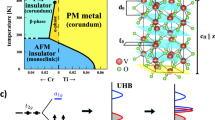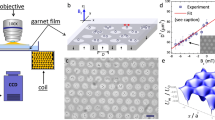Abstract
The spontaneous formation of organized surface structures at nanometre scales1,2 has the potential to augment or surpass standard materials patterning technologies. Many observations of self-organization of nanoscale clusters at surfaces have been reported1,2,3,4,5,6,7,8,9,10, but the fundamental mechanisms underlying such behaviour — and in particular, the nature of the forces leading to and stabilizing self-organization — are not well understood. The forces between the many-atom units in these structures, with characteristic dimensions of one to tens of nanometres, must extend far beyond the range of typical interatomic interactions. One commonly accepted source of such mesoscale forces is the stress field in the substrate around each unit1,11,12,13. This, however, has not been confirmed, nor have such interactions been measured directly. Here we identify and measure the ordering forces in a nearly perfect triangular lattice of nanometre-sized vacancy islands that forms when a single monolayer of silver on the ruthenium (0001) surface is exposed to sulphur at room temperature. By using time-resolved scanning tunnelling microscopy to monitor the thermal fluctuations of the centres of mass of the vacancy islands around their final positions in the self-organized lattice, we obtain the elastic constants of the lattice and show that the weak forces responsible for its stability can be quantified. Our results are consistent with general theories of strain-mediated interactions between surface defects in strained films.
This is a preview of subscription content, access via your institution
Access options
Subscribe to this journal
Receive 51 print issues and online access
$199.00 per year
only $3.90 per issue
Buy this article
- Purchase on Springer Link
- Instant access to full article PDF
Prices may be subject to local taxes which are calculated during checkout



Similar content being viewed by others
References
Seul, M. & Andelman, D. Domain shapes and patterns: the phenomenology of modulated phases. Science 267, 476–483 (1995).
Itano, W. M. et al. Bragg diffraction from crystallized ion plasmas. Science 279, 686–689 (1998).
Evans, J. H. Observations of a regular void array in high purity molybdenum irradiated with 2 MeV nitrogen ions. Nature 229, 403–404 (1971).
Asai, M., Ueba, H. & Tatsuyama, C. Heteroepitaxial growth of Ge films on the Si(100)-2×1 surface. J. Appl. Phys. 58, 2577–2583 (1985).
Kern, K. et al. Long-range spatial self-organization in the adsorbate-induced restructuring of surfaces: Cu{110}-(2×1)O. Phys. Rev. Lett. 67, 855–858 (1991).
Hörnis, H., West, J. R., Conrad, E. H. & Ellialtioglu, R. Island ordering on clean Pd(110). Phys. Rev. B 47, 13055–13058 (1993).
Zeppenfeld, P., Krzyzowski, M. A., Romainczyk, Ch., David, R. & Comsa, G. Stability of disk and stripe patterns of nanostructures at surfaces. Surf. Sci. 342, L1131–L1136 (1995).
Haasen, P. Physical Metallurgy 256 (Cambridge Univ. Press, New York, (1996)).
Tersoff, J., Teichert, C. & Lagally, M. G. Self-organization in growth of quantum dot superlattices. Phys. Rev. Lett. 76, 1675–1678 (1996).
Parker, T. M., Wilson, L. K., Condon, N. G. & Leibsle, F. M. Epitaxy controlled by self-assembled nanometer-scale structures. Phys. Rev. B 56, 6458–6461 (1997).
Vanderbilt, D. Phase segregation and work-function variations on metal surfaces: spontaneous formation of periodic domain structures. Surf. Sci. 268, L300–L304 (1992).
Ng, K. -O. & Vanderbilt, D. Stability of periodic domain structures in a two-dimensional dipolar model. Phys. Rev. B 52, 2177–2183 (1995).
Ibach, H. The role of surface stress in reconstruction, epitaxial growth and stabilization of mesoscopic structures. Surf. Sci. Rep. 29, 193–263 (1997).
Stevens, J. L. & Hwang, R. Q. Strain stabilized alloying of immiscible metals in thin films. Phys. Rev. Lett. 74, 2078–2081 (1995).
Hwang, R. Q., Hamilton, J. C., Stevens, J. L. & Foiles, S. M. Near-surface buckling in strained metal overlayer systems. Phys. Rev. Lett. 75, 4242–4245 (1995).
Morgenstern, K., Rosenfeld, G., Poelsema, B. & Comsa, G. Brownian motion of vacancy islands on Ag(111). Phys. Rev. Lett. 74, 2058–2061 (1995).
de la Figuera, J., Prieto, J. E., Ocal, C. & Miranda, R. Creation and motion of vacancy islands on solid surfaces: a direct view. Solid State Commun. 89, 815–818 (1994).
Nelson, D. R. & Halperin, B. I. Dislocation-mediated melting in two dimensions. Phys. Rev. B 19, 2457–2484 (1979).
Huse, D. A. Shape of diffraction peaks of a two-dimensional solid. Phys. Rev. B 28, 6110–6111 (1983).
Morgenstern, K., Rosenfeld, G. & Comsa, G. Decay of two-dimensional Ag islands on Ag(111). Phys. Rev. Lett. 76, 2113–2116 (1996).
Acknowledgements
This work was supported by the Office of Basic Energy Sciences of the US DOE, Divisions of Materials Science and Chemical Science. J.d.l.F. also acknowledges support from the Fulbright Commission and the Spanish MEC.
Author information
Authors and Affiliations
Corresponding author
Rights and permissions
About this article
Cite this article
Pohl, K., Bartelt, M., de la Figuera, J. et al. Identifying the forces responsible for self-organization of nanostructures at crystal surfaces. Nature 397, 238–241 (1999). https://doi.org/10.1038/16667
Received:
Accepted:
Issue Date:
DOI: https://doi.org/10.1038/16667
This article is cited by
-
Ordered Patterns of Copper Phthalocyanine Nanoflowers Grown Around Fe Islands on Au(111)
Journal of Cluster Science (2022)
-
Nano-sized Adsorbate Structure Formation in Anisotropic Multilayer System
Nanoscale Research Letters (2017)
-
Stability of multi-component epilayers and nanopattern formation
Journal of Nanoparticle Research (2004)
Comments
By submitting a comment you agree to abide by our Terms and Community Guidelines. If you find something abusive or that does not comply with our terms or guidelines please flag it as inappropriate.



